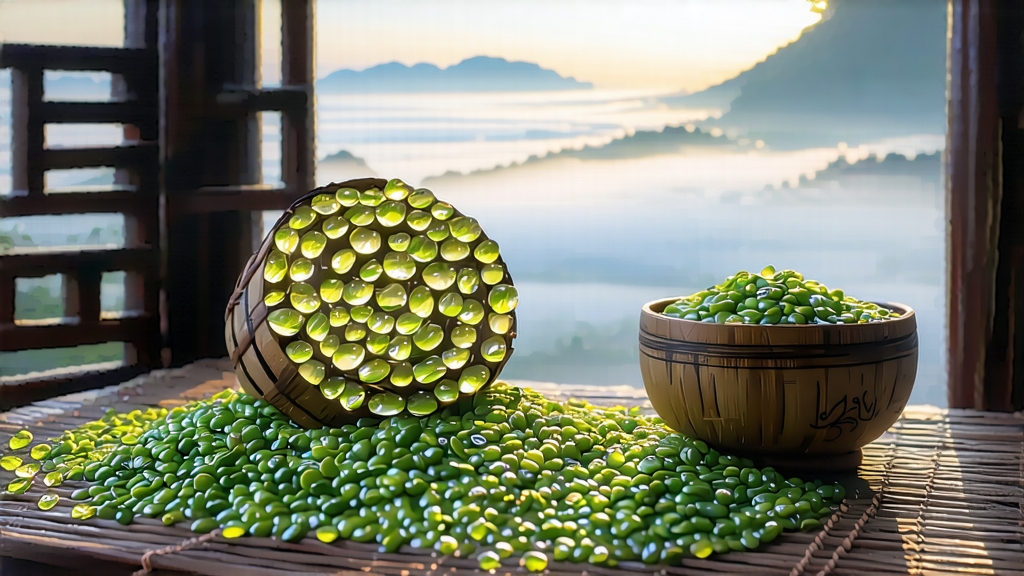
Among the pantheon of Chinese green teas, few names evoke as much romance and sensory delight as Biluochun. Literally “Green Snail Spring,” this delicate curl of leaf is prized for its improbable fragrance—an intoxicating fusion of apricot, orchid and seawater that seems impossible to coax from a single tea bud. Yet for more than a thousand years the hills curled around Lake Tai in Jiangsu Province have performed exactly that alchemy, turning the dawn mist and mountain soil into one of China’s ten most celebrated teas.
Historical whispers place Biluochun’s birth during the Tang dynasty (618-907), when it was known among monks as “Xia Sha Ren Xiang”—“Scary-Fragrant” because its perfume was thought bewitching. The modern name was supposedly bestowed by the Kangxi Emperor (r. 1661-1722) while on a southern inspection tour. Presented with the tea, he was struck by its tight spiral resembling a snail shell and the fact that it was picked in early spring; he instantly rechristened it “Biluochun,” a poetic upgrade that secured its place in imperial tribute records. From the Qing court the tea traveled along the Grand Canal to Beijing, then by merchant caravans to the Russian Far East and, eventually, the European salons of the nineteenth century, where connoisseurs compared its aroma to “a basket of ripe melons hidden in wet moss.”
Geographically, authentic Biluochun comes from only two narrow zones: Dongting East Mountain (Dongshan) and Dongting West Mountain (Xishan), rocky peninsulas that jut into Lake Tai like the pincers of a jade crab. The lake’s vast surface moderates temperature, creating a humid cloak of fog that filters sunlight into a soft, diffused glow. On these slopes, tea bushes intermingle with peach, plum and loquat trees; their falling petals and fragrant roots season the soil, accounting for the tea’s signature fruity note. Within the micro-region, cultivars range from the traditional small-leaf “Dongting Qunti” to the newer but increasingly popular “Fuding Dabaicha” clone, each lending subtle differences in sweetness and texture.
Crafting Biluochun is a race against time and oxidation. Picking begins around the Qingming festival (early April) when nights are still cool and buds are tightly closed. Only the topmost “single bud with one unfolding leaf” is plucked, ideally before seven in the morning while dew still glistens. A skilled picker gathers barely 500 grams of fresh leaf in a day—enough, once finished, for a scant 100 grams of dry tea. The harvest is rushed to the village workshop where it undergoes “killing green” (shaqing) in woks heated to 180 °C. The tea master tosses the leaves with bare hands, feeling for the moment cellular moisture bursts and grassy notes subside. Within minutes the temperature is lowered to 80 °C and the shaping begins: palms press and rub the leaves against the wok in a spiral motion, coaxing them into the iconic snail curl while residual moisture escapes in fragrant puffs. Finally, the tea is gently pan-dried at 60 °C until moisture falls below seven percent, locking in the vivid jade color and volatile aromatics. The entire process—from tree to tin—takes less than four hours, a choreography perfected over centuries.
To brew Biluochun properly is to court subtlety. Its downy buds are fragile, easily scalded into bitterness. Begin with a tall, thin glass or a 150 ml gaiwan so the unfolding dance can be observed. Use water at 75 °C—cooler than most greens—drawn from a living spring if possible; the tea’s delicate aromatics clash with heavily chlorinated sources. Measure three grams (about a heaping teaspoon) and rinse the vessel first to pre-warm, then empty and add the dry leaves. Before the first infusion, pause to savor the “dry aroma”: cup the glass, inhale gently, and note the interplay of magnolia and salted apricot. Pour 80 ml of water along the wall, not directly onto the leaves, and steep for thirty seconds. The buds sink, then slowly unfurl like miniature ferns releasing a pale champagne liquor. Decant entirely to avoid over-extraction; subsequent infusions add five seconds each, yielding up to four flavorful st